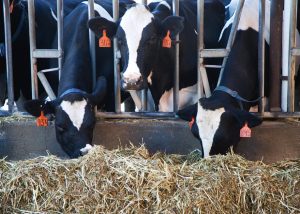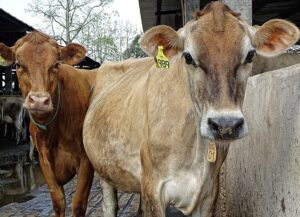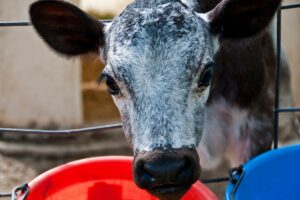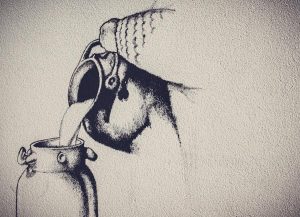Alvaro Garcia
The two leading causes of death losses in un-weaned calves are scours and the bovine respiratory disease complex (BRD). Heifers that survive continue to perform poorly as adult cows. Respiratory disease in calves is characterized by irritation and inflammatory response of the upper respiratory tract. When left untreated, oftentimes evolves into bronchopneumonia. The disease has traditionally been recognized as initially viral in nature, secondarily complicated by bacteria. This viral-bacterial interaction is accelerated by factors of the calves’ environment and/or their immune status.
A critical component of addressing BRD is to identify its causes. Effective treatment should be determined by correct identification of the pathogens since indiscriminate antibiotic use to combat secondary bacteria is discouraged. Sampling of the respiratory tract is increasingly recommended including deep nasopharyngeal swabs, trans-tracheal washes, and non-endoscopic bronchoalveolar lavage. Polymerase Chain Reaction (PCR) is also becoming popular, with the main advantages that: viruses and bacteria can be tested, its highly sensitivity, and it’s possible to test pooled samples from group of calves. In order to prevent this costly problem however, it is important to address both predisposing and pathogen-specific risk factors.
Predisposing Factors
Colostrum and environment. To survive the microbial challenges posed immediately after birth, “wet calves” must have adequate immunity. Before their own immune system develops, they need to rely on the passive immunity transferred from the cow through colostrum. Calves should receive 3–4 quarts of high-quality colostrum within 1 hour of birth and 3 additional quarts within 12 hours. One method to verify if colostrum supplied adequate immunity is to measure either immunoglobulins directly or serum total protein in blood serum. Serum total protein measured with a refractometer is highly correlated with serum IgG levels. It is better to measure serum total protein in a group of calves than individual calf readings. At least 80 per cent of those calves should have serum protein levels of 5.5 g/dL or higher. While timely colostrum administration is critical, so is proper handling, as colostrum can be an ideal growth medium for bacteria. It is critical to refrigerate or freeze as soon as possible if it is not going to be used immediately. On-farm pasteurization is an alternative since it does not affect immunoglobulins. Batch pasteurizers use relatively lower temperatures and a longer heating time (60°C for 60-120 minutes).
Raising calves in enclosed barns is convenient, the only problem is that stationary, warm air can contain potentially harmful gases (i.e., ammonia), odor, dust, and microorganisms (e.g., fungal spores, viruses, and bacteria). Ammonia irritates the alveoli of the lungs, and dust oftentimes carry microbes that reach respiratory tissues and multiply. Other factors that increase the risk of BRD are shared housing with cows during the first week of life, having more than two months age difference in age in a group, previous episodes of diarrhea, and leaving calves with dams for more than 24 hours post calving. Clean-and-dry quarters are critical to reduce the incidence of BRD. To reduce bacterial numbers, increase the pen area (3 m2 or more/calf), and decrease pen temperature. Cold-temperature (5°C) housing is beneficial since bacterial growth is reduced under cold conditions. Calves subjected to cold conditions will eat more grain starter, maintaining good growth rates. Adequate ventilation (no drafts!) will reduce bacterial counts and ammonia. To cope with cold temperatures, calves need adequate nutrition and a dry, well-insulated surface to rest on. Characteristics desired in bedding for calves are good moisture absorbance and the ability to keep the body warm. Wheat straw allows the calf to “nest” and has the warmest surface temperature compared to rice hulls and wood shavings; sand is the cleanest but also the coldest!
Determinant factors
Microorganisms. Assuming calves have received adequate immunity through colostrum, a next important step is to reduce the microbial challenge. To accomplish this, remove the calf from the cow as soon as possible. Place calves in their own quarters in individual pens that help them avoid nose-to-nose contact with other calves. This will help calves cope with stress by reducing exposure to pathogens from the cow and other calves. There should be ample dry bedding that will provide comfort and insulation from the cold. Be sure to avoid dusty bedding materials (e.g., sawdust), since dust irritates the respiratory tract and facilitates the attack by bacteria.
Numerous vaccines are available for calves to prevent BVD. Traditional views have held that the antibodies the calf receives through colostrum usually cause administered vaccines to be ineffective. Recent research indicates that modified live viral vaccines stimulate a protective response despite the inability to measure an active antibody response in the bloodstream. One example is the use of intranasal IBR/Pi3 vaccines in calves less than 1 month old. Other work has demonstrated that modified live virus BVDV vaccines provide immunity when given to calves as young as six weeks of age. Little has been published regarding the effectiveness of vaccines against bacterial pneumonia pathogens such as Pasteurella multocida, Mannheimia hemolytica, or Mycoplasma bovis when administered to young calves.
A recent article (Pardon et al., 2020) for example attempted to identify pathogen-specific risk factors for viruses and bacteria involved in epidemic outbreaks of BRD. As could be expected this study showed that epidemic BRD peaked in winter and was initially of viral origin. Bovine coronavirus (BCoV) was the most prevalent virus (increasingly recognized universally as the main factor), followed by bovine Respiratory Syncytial Virus (bRSV). In the participating herds 36.8% reported epidemic respiratory disease only, while 63.2% reported endemic respiratory disease. At sampling time 44.0 ± 30.1% of the calves had BRD for both epidemic and endemic type herds.
Viruses were detected in 58.6% of the outbreaks as follows: 29.4% bRSV, 8.1% Parainfluenza-3 (PI-3), and 38.4% bovine coronavirus (BCoV). Multiple viruses were involved in 13.3% of the herds, with only 4 herds showing bRSV as the single pathogen. Bacteria prevalence was 41.2% M. haemolytica, 89.1% P. multocida, 36.4% H. somni, and 33.3% M. bovis. In 61.0% of M. bovis positive outbreaks, a virus was also detected (72.0% BCoV, 16.0% PI-3, and 12.0% bRSV).
Virus and bacteria specific risk factors
Factors associated with a positive bRSV were days with clinical signs before sampling, percentage of calves with respiratory signs, endemic respiratory disease, vaccination against bRSV, PI-3-positive bronchoalveolar lavage, and season. In winter (December-March), bRSV was significantly more frequent compared with summer and spring.
For bacteria, there were associations between positive result for M. haemolytica and group size of pen, bedding type, and BCV-positive result. Analysis for H. somni identified positive associations with M. haemolytica vaccination, bedding type, and herd size. Finally, for M. bovis recently purchased animals present in the same air space was the most significant factor.
Bovine coronavirus it’s still considered as the major initiator of secondary respiratory infections in BRD in calves. In this study this virus was associated with M. haemolytica. Another virus detected was bRSV despite high vaccination rates observed in these farms. The PI-3 virus was not frequently detected as single agent but always associated with bRSV. In spite of M. bovis, usually recognized as a chronic pathogen, in this experiment it was often detected in acute outbreaks. In one-third of the herds M. haemolytica and H. somni, were present with P. multocida appearing only as ubiquitous. Larger groups of calves (more than 5) had more M. haemolytica prevalence. Using sawdust was a risk factor for both M. haemolytica and H. somni. Sawdust is well- known for irritating the respiratory tract and, when wet, might worsen cold stress as explained above. Vaccinated and not vaccinated herds had similar incidence of the pathogens. The authors hypothesized that rather than preventing infection vaccines reduce shedding and clinical signs.
It was concluded that viral infections continue to predispose to the BRD complex. It was also pbserved that bRSV had an important role in outbreaks of BRD, particularly during winter. Bovine coronavirus in this experiment was associated with M. haemolytica. It is important for animal health professionals to also consider predisposing factors such as the choice of bedding.
Reference
Pardon, J. Callens, J. Maris, L. Allais, W. Van Praet, P. Deprez, and S. Ribbens. 2020. Pathogen-specific risk factors in acute outbreaks of respiratory disease in calves. J. Dairy Sci. 103:2556–2566.
© 2020 Dairy Knowledge Center. All Rights Reserved.









